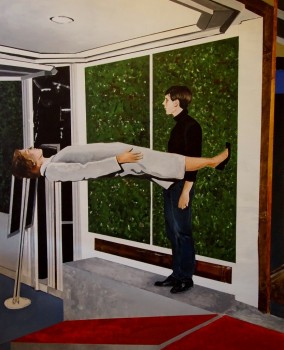 Miguel Laino’s art is on exhibit at the Eckleburg Gallery. Recently, he chatted with Eckleburg about achieving purity in his paintings.
Miguel Laino’s art is on exhibit at the Eckleburg Gallery. Recently, he chatted with Eckleburg about achieving purity in his paintings.
Eckleburg: Your characters seem to be part of an absurd scene or one of melancholy. Is this intentional?
ML: My work is first and foremost figurative. Shape and composition is my primary concern, closely followed by a sense of ambiguity or a wide range of possible interpretations as to what the image depicts or means. Depending on the interpretation, a particular emotion or range of emotions may be elicited. But that response will depend on the viewer. One person may see an image as melancholy, another may find humour or absurdity in it. I don’t attempt to infuse a particular emotion. I just try to be true to the essence of an image while instinctively re-inventing aspects of its form.
Eckleburg: In this piece, why does the cardinal hurry?
ML: I’m not sure really. But I’m glad the sense of movement comes across in the painting! That sense of motion and the vividness of the color were my main objectives.
Eckleburg: How do you see your artistry evolving?
ML: I see my overall body of work evolving in the same way that an individual piece evolves – organically, instinctively, towards a more realized version of itself. Our work or output as human beings reflects, or should reflect, our personal growth. I have an inkling that my palette may expand a bit and perhaps include more vivid colours, but I’m just following the flow and keeping steady in my practice. The rest will follow naturally.
Eckleburg: What about the print media motivates you?
ML: I don’t know that it motivates me in and of itself. But our society has perhaps more ready access to imagery than any other in history. In fact, we are bombarded by it whether we like it or not. We have all these added freedoms that come with technology, but the level of responsibility for our choices is just as immense. It’s about finding things that resonate with you, that you can relate to, and being selective with the imagery and ideologies that are streaming towards us all the time. Infinite choice demands infinite wisdom.
Eckleburg: Has living in London changed your approach to art?
ML: Growing up in rural Spain, I was always attracted to the idea of living in a big metropolis like New York or London. I always had that urban sensibility, in spite of the environment I was in. Actually, moving to London and living that dream has just crystallized things and given me licence and confidence to follow my intuitions and instincts, and to be true to myself in my work.
Eckleburg: Is there a thought or an emotion you hope to convey through art that you have not yet?
ML: I like my work to have a certain austerity or simple purity, which may evoke certain emotions in some people. I want to make pictures that engage and intrigue people; that reach people in ways personal for them; and that are somehow mysterious and yet essentially familiar — like a sense of deja vu, or a half-remembered dream.
Miguel Laino was born in southern Spain and has been living in London since 2001, when he arrived to complete a degree at Central St Martins College. His work is an interpretation of images from online and print media that he is instinctively drawn to. He also makes use of collage to create his own unique compositions. This allows him to combine images from different genres and time periods, so that the finished work reflects the fact that what is contemporary is part of a continuum that contains, and is influenced by, the past. Besides being a snapshot of current events, what is contemporary can also be both an acknowledgement of the past and a glimpse into the future.

